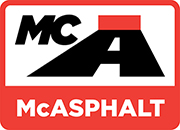Sand Seals
A sand seal is a spray application of asphalt emulsion followed with a light covering of fine aggregate, such as a clean sand or screenings. Although this is a simple operation, it can be useful in correcting a number of pavement flaws. Emulsion is usually sprayed between 0.7 l/m2 to 1.25 l/m2 and sand is placed at 5.5 kg/m2 to 12 kg/m2 as a cover.
Design Criteria
When designing a sand seal a number of factors have to be examined and assessed to ensure a proper surface will be placed that will perform for its service life. The following factors can have a tremendous effect on the performance of a sand seal; traffic, aggregate shape, existing surface and residual asphalt content. If these factors are addressed the chances of a good sand seal being placed are greatly increased.
Traffic:
The type and quantity of traffic will have a large effect on the amount of asphalt emulsion to be used as well as the emulsion type.
Aggregate Shape:
The overall shape of the cover aggregate can influence the quantity of aggregate as well as the amount of asphalt emulsion to be used. The angularity of the aggregate will affect the performance of the finished seal.
Existing surface:
The texture and condition of the existing road surface will affect the aggregate type, quantity and spray rate. A dry porous road surface may need a higher quantity of emulsion.
Asphalt Residual in the Emulsion:
The quantity of asphalt residual in the emulsion can affect the quantity of emulsion needed to hold the cover aggregate. The lower the residual the higher the quantity of asphalt emulsion needed.
If these factors are taken into consideration in designing the sand seal then the chances of a successful seal are greatly improved. Typically a sand seal would require an emulsion application rate of 0.65 – 0.90 l/sqm and a cover aggregate quantity of 5 – 8 kgs/sqm.
Materials
Asphalt Emulsions:
A number of different grades of asphalt emulsion can be used in sand seals. The proper emulsion to be used has to be determined by running compatibility tests between the emulsion and the aggregate to be used. Typically the most common emulsions used are RS-1, RS-2, CRS-1 and CRS-2.
Cover Aggregate:
The type of cover aggregate used in sand seals must meet certain requirements of shape, size, cleanliness. The aggregate should have a maximum size of 4.75 mm and should have a relatively low amount passing the 75 micron sieve size (2 – 5%). Also the asphalt emulsion to be used and the aggregate must be compatible to ensure the asphalt-aggregate bond is effective.
Performance Guidelines
In order to construct a proper well designed sand seal the following guidelines should be followed:
- Design a sand seal with aggregate to be used on job
- Use a clean sand or screenings
- Ensure compatibility of aggregate and emulsion
- Calibrate and inspect all equipment.
- Use sufficient number and properly pneumatic rollers.
- Follow proper construction techniques.
- Use traffic control to protect seal
- Work only in weather suitable for type and grade of emulsion being used
